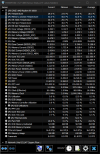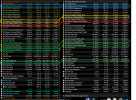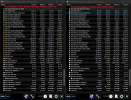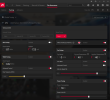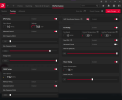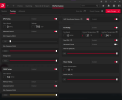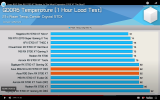Greetings everyone!
Maybe one of you can answer me regarding my concerns with my ASUS TUF RX 6800.
It seems that according to HWinfo that the GPU Memory Junction Temperature is always a lot higher than my GPU Hot Spot and when compared to other RX 6000 series GPUs that I found data on online.
Even when completely idle and nothing else running in the background except HWinfo, VRAM junction temps stay at roughly 54°C while my GPU hot spot is down to roughly 38°C.
Under a gaming load I've seen the VRAM junction temperature go up to roughly 84°C while the GPU Hot Spot is at roughly 77°C, so the gap is closing. However, when I drop the load, GPU Hot Spot temps go down fairly quickly while VRAM junction temperature drops only fairly slowly, leading me to believe there is something wrong somewhere. Just playing YT videos in Firefox will slowly heat up the VRAM junction temps to roughly 70°C where it stabilizes. The fan stays at 0 RPM in the YT scenario because the GPU Temperature is staying just below 55°C.
I haven't disassembled my card because I might have to RMA it but from the outside looking through the gaps I can at least confirm that all memory modules seems to have thermal pads which seem to be making contact with the heat sink. The backside of the PCB also has thermal pads connecting them to the backplate where the memory modules are.
While looking into different models I haven't come across someone posting anything about this specific model, only the one video on from Hardware Unboxed regarding the XT version (which is using the exact same cooler) praising the overall temperatures including memory temps, though I don't know what they used to measure the temperature.
According to GPU-Z, my GPU is using GDDR6 from SK Hynix, maybe those just run hotter than Micron or Samsung VRAM?
From what I understand, only the highest VRAM junction temps get reported, is that right? It would be really nice to see the readouts of multiple memory modules to confirm if one is behaving abnormally.
Anyway, thank you for taking the time to read this.
Edit: By the way, I've also written a mail to ASUS regarding this. Haven't received any reply yet but I will update this if they do reply.
Maybe one of you can answer me regarding my concerns with my ASUS TUF RX 6800.
It seems that according to HWinfo that the GPU Memory Junction Temperature is always a lot higher than my GPU Hot Spot and when compared to other RX 6000 series GPUs that I found data on online.
Even when completely idle and nothing else running in the background except HWinfo, VRAM junction temps stay at roughly 54°C while my GPU hot spot is down to roughly 38°C.
Under a gaming load I've seen the VRAM junction temperature go up to roughly 84°C while the GPU Hot Spot is at roughly 77°C, so the gap is closing. However, when I drop the load, GPU Hot Spot temps go down fairly quickly while VRAM junction temperature drops only fairly slowly, leading me to believe there is something wrong somewhere. Just playing YT videos in Firefox will slowly heat up the VRAM junction temps to roughly 70°C where it stabilizes. The fan stays at 0 RPM in the YT scenario because the GPU Temperature is staying just below 55°C.
I haven't disassembled my card because I might have to RMA it but from the outside looking through the gaps I can at least confirm that all memory modules seems to have thermal pads which seem to be making contact with the heat sink. The backside of the PCB also has thermal pads connecting them to the backplate where the memory modules are.
While looking into different models I haven't come across someone posting anything about this specific model, only the one video on from Hardware Unboxed regarding the XT version (which is using the exact same cooler) praising the overall temperatures including memory temps, though I don't know what they used to measure the temperature.
According to GPU-Z, my GPU is using GDDR6 from SK Hynix, maybe those just run hotter than Micron or Samsung VRAM?
From what I understand, only the highest VRAM junction temps get reported, is that right? It would be really nice to see the readouts of multiple memory modules to confirm if one is behaving abnormally.
Anyway, thank you for taking the time to read this.
Edit: By the way, I've also written a mail to ASUS regarding this. Haven't received any reply yet but I will update this if they do reply.

